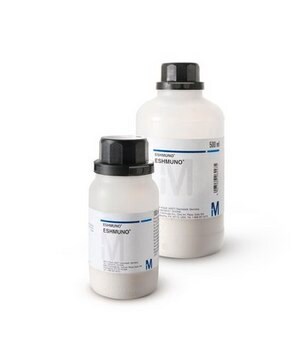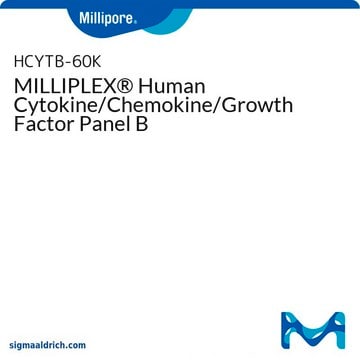HNDG4MAG-36K
MILLIPLEX® Human Neurodegenerative Disease Magnetic Bead Panel 4 - Neuroscience Multiplex Assay
The analytes available for this multiplex kit are: Amyloid β40, Amyloid β42, GDNF, sRAGE, S100B.
About This Item
Recommended Products
Quality Level
species reactivity
human
manufacturer/tradename
Milliplex®
assay range
accuracy: 84-108%
standard curve range: 14-10,000 pg/mL
(S100B)
standard curve range: 21-15,000 pg/mL
(sRAGE)
standard curve range: 27-20,000 pg/mL
(Amyloid β42)
standard curve range: 3-2,500 pg/mL
(Amyloid β40)
standard curve range: 7-5,000 pg/mL
(GDNF)
technique(s)
multiplexing: suitable
detection method
fluorometric (Luminex xMAP)
shipped in
wet ice
General description
Panel Type: Neuroscience
Specificity
Cross-reactivity between the antibodies and any of the other analytes in this panel is non-detectable or negligible.
Application
- Analytes: Amyloid β40, Amyloid β42, GDNF, sRAGE, S100B
- Recommended Sample type: CSF
- Recommended Sample dilution: 1:3
- Assay Run Time: Overnight
- Research Category: Neuroscience
Features and Benefits
Packaging
Storage and Stability
Other Notes
Legal Information
Disclaimer
Signal Word
Danger
Hazard Statements
Precautionary Statements
Hazard Classifications
Acute Tox. 3 Dermal - Acute Tox. 4 Inhalation - Acute Tox. 4 Oral - Aquatic Chronic 2 - Skin Sens. 1
Storage Class Code
6.1C - Combustible acute toxic Cat.3 / toxic compounds or compounds which causing chronic effects
Certificates of Analysis (COA)
Search for Certificates of Analysis (COA) by entering the products Lot/Batch Number. Lot and Batch Numbers can be found on a product’s label following the words ‘Lot’ or ‘Batch’.
Already Own This Product?
Find documentation for the products that you have recently purchased in the Document Library.
Related Content
Multiplex detection of Alzheimer's biomarkers with MILLIPLEX® Human Amyloid Beta and Tau Magnetic Bead Panel aids research.
Neuroscience multiplex assays measure biomarkers to understand neurodegenerative diseases, disorders, and neuropeptide signaling.
Our team of scientists has experience in all areas of research including Life Science, Material Science, Chemical Synthesis, Chromatography, Analytical and many others.
Contact Technical Service









